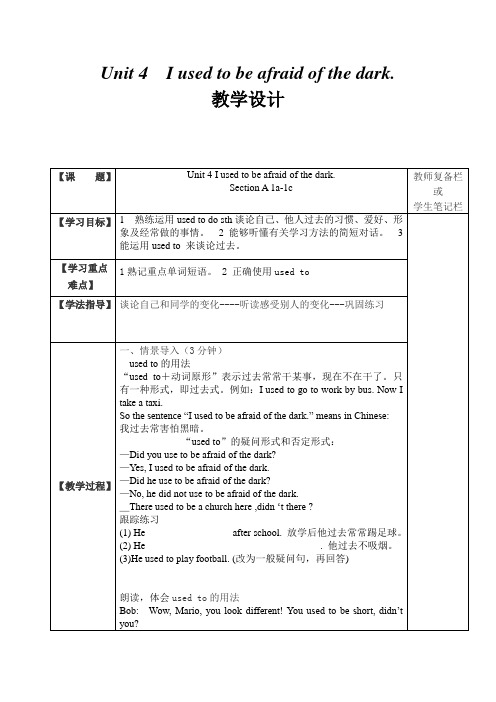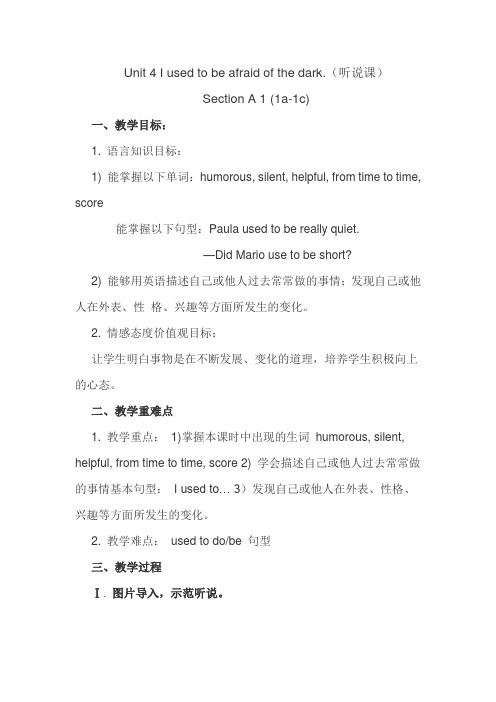Unit4 I used to be afraid of the dark教学课件0001
- 格式:ppt
- 大小:4.44 MB
- 文档页数:12

Unit 4 I used to be afraid of the dark.教学设计【课题】Unit 4 I used to be afraid of the dark.Section A 1a-1c 教师复备栏或学生笔记栏【学习目标】1 熟练运用used to do sth谈论自己、他人过去的习惯、爱好、形象及经常做的事情。
2 能够听懂有关学习方法的简短对话。
3能运用used to 来谈论过去。
【学习重点难点】1熟记重点单词短语。
2 正确使用used to【学法指导】谈论自己和同学的变化----听读感受别人的变化---巩固练习【教学过程】一、情景导入(3分钟)used to的用法“used to+动词原形”表示过去常常干某事,现在不在干了。
只有一种形式,即过去式。
例如:I used to go to work by bus. Now I take a taxi.So the sentence “I used to be afraid of the dark.” means in Chinese:我过去常害怕黑暗。
“used to”的疑问形式和否定形式:—Did you use to be afraid of the dark?—Yes, I used to be afraid of the dark.—Did he use to be afraid of the dark?—No, he did not use to be afraid of the dark._There used to be a church here ,did n …t there ?跟踪练习(1) He______ ______ ____ after school. 放学后他过去常常踢足球。
(2) He ____ ______ _____ __________________. 他过去不吸烟。
(3)He used to play football. (改为一般疑问句,再回答)_______________________________________________________朗读,体会used to的用法Bob: Wow, Mar io, you look different! You used to be short, didn‟t you?【教学过程】Mario: Yes, I did. Now I‟m tall. And so are you!Bob: That‟s true. And you used to wear glasses.Amy: Hi, Bob. How are you?Bob: Fine. Wow, you‟ve changed!Amy: Really? How?Bob: You used to have short hair.Amy: You remember that? Yes, I did.二、自主探究( 6分钟)朗读、翻译短语I haven‟t seen you for four years! a couple of days.Now I‟m tall. And so are you!you used to wear glasses. you‟ve changed!You used to have short hair.you used to be really tall! Not anymore.it used to be red, didn‟t it?it used to be curly. You used to be short, didn‟t you? 复习反意疑问句,完成练习:(1)Lily will go to China, ______ _____?(2)She doesn‟t come from China, ________ ________?(3) You haven‟t finis hed homework, _________ __ ?(4) He knows little English, _________ ______?三、合作探究( 10分钟)注意谈论外貌和性格的不同句型What‟s he\ she like ?What does he\ she look like?完成1a两人一组谈论自己过去的外表、性格等及与现在的不同。

Unit 4 I used to be afrd of the dark(第4课时)教学设计一. 教材分析《I used to be afrd of the dark》是人教版PEP小学英语第四册Unit 4的主题句,本课主要讲述过去和现在的对比。
教材内容贴近学生生活,易于激发学生的学习兴趣。
通过本课的学习,学生能够掌握一般过去时态,并能够运用句型“—Did you use to do sth? —Yes, I did./No, I didn’t.”进行问答。
二. 学情分析根据四年级学生的认知特点,他们已经具备了一定的英语听说能力,能够理解和运用一些简单的英语句型。
但部分学生对一般过去时态的掌握尚有困难,需要在教学中给予重点辅导。
学生在日常生活中对过去和现在的对比有丰富的经历,可以借助生活经验更好地理解和运用所学知识。
三. 教学目标1.知识目标:学生能够掌握一般过去时态,理解并运用句型“—Did youuse to do sth? —Yes, I did./No, I didn’t.”进行问答。
2.能力目标:学生能够在日常生活中运用所学知识进行交流,提高英语听说能力。
3.情感目标:通过对比过去和现在,学生能够珍惜现在的生活,积极面对未来。
四. 教学重难点1.重点:学生能够掌握一般过去时态,运用句型进行问答。
2.难点:学生能够灵活运用一般过去时态,表达自己的过去和现在的对比。
五. 教学方法采用情景教学法、交际法、任务型教学法等多种教学方法,激发学生的学习兴趣,提高学生的英语听说能力。
六. 教学准备1.教学课件:制作包含图片、动画等多媒体元素的教学课件,生动展示过去和现在的对比。
2.教学道具:准备一些与过去和现在相关的实物道具,如玩具、衣物等,方便学生直观感受。
3.练习题:设计一些练习题,用于巩固所学知识。
七. 教学过程1.导入(5分钟)利用课件展示一些过去和现在的对比图片,如玩具、衣物、交通工具等,引导学生谈论过去和现在的变化。

Unit 4 I used to be afraid of the dark.(听说课)Section A 1 (1a-1c)一、教学目标:1. 语言知识目标:1) 能掌握以下单词:humorous, silent, helpful, from time to time, score能掌握以下句型:Paula used to be really quiet.—Did Mario use to be short?2) 能够用英语描述自己或他人过去常常做的事情;发现自己或他人在外表、性格、兴趣等方面所发生的变化。
2. 情感态度价值观目标:让学生明白事物是在不断发展、变化的道理,培养学生积极向上的心态。
二、教学重难点1. 教学重点:1)掌握本课时中出现的生词humorous, silent, helpful, from time to time, score 2) 学会描述自己或他人过去常常做的事情基本句型:I used to… 3)发现自己或他人在外表、性格、兴趣等方面所发生的变化。
2. 教学难点:used to do/be 句型三、教学过程Ⅰ. 图片导入,示范听说。
大屏幕展示几张形容外貌及性格的照片,引导学生们来描述他的长相点。
T: What does he look like?S1:He has long curly blonde hair.S2: He has a round face, two big eyes. He’s a little heavy.T: Does he like his hair? Can you guess?S1:No, he does. He wants to cut it short. S2: …II. 情景模拟,小组合作。
Let Ss describe their best friend .Use these words . Appearance: tall, straight hair, short, of medium height, straight/curly hair,long/short hair, heavy, thin, of medium built … Personality: Outgoing, shy, funny, serious, cute, quiet, kind, brave, friendly, activeⅢ.深化活动,展示交流。

Section A 1 (1a-2d)教学目标:知识与技能:掌握重点句型:Mario, you used to be short, didn’t you? Yes, I did.He used to wear ...She used to have...掌握重点短语和单词:used to do sth. humorous. silent. helpful. from time to time. score.过程与方法:学生能运用used to结构,谈论学生自己怎样与过去不同,能准确地描述自己的外貌、性格的变化,灵活运用used to 结构处理和传递信息。
能够表达自己现在和过去在外表、性格、娱乐等方面的变化。
情感态度与价值观:培养学生积极健康的心态,学会谈论事物的发展和变化,明白事物是不断发展、变化的道理。
教学重点、难点:重点词汇:used to do sth. 过去经常 humorous 幽默的 silent 沉默的helpful 有用的 from time to time 时常 score 得分教学难点:1.本单元主要内容是学会used to结构。
Used to +动词原形表示过去经常、以前常常,只用于过去式中,用来表示现在已不存在的习惯或状态。
例如:They used to play football together.他们过去常在一起蹋足球。
(现在不在一起踢了)2.used to的疑问形式和否定形式为Did you use to…?和I didn’t use to… 也可以用Used you to…?和I used not to…但现在多使用前者。
教学方法:任务型教学法以及小组合作学法:小组合作、练习法教学准备:ppt课时安排:第一课时Section A 1 (1a-2d)第二课时Section A 2 (3a-3c)第三课时Section A 3 (Grammar Focus-4c)第四课时Section B1 (1a-2f)第五课时Section B 2 (3a-Self Check)Section A 1 (1a-2d)教学目标:知识与技能:能掌握以下单词:humorous, silent, helpful, from time to time, score能掌握以下句型:① Paula used to be really quiet.②—Did Mario use to be short? —Yes, he did.③—What’s he like now? —He’s tall now.过程与方法:能够用英语描述自己或他人过去常常做的事情;发现自己或他人在外表、性格、兴趣等方面所发生的变化。

Unit4 I used to be afraid of the dark教学设计(说课)李莉各位老师你们好!今天我要为大家讲的课题是:九年级Unit4 I used to be afraid of the dark本人将从教材分析、学情分析、教学目标、教学方法及设计意图、教学过程、板书设计等六个方面进行说课。
一、教材分析(说教材):本节课的核心话题为“talk about what they used to be like”,围绕着谈论过去自己和他人过去经常做的事,谈论自己和他人过去的外貌\性格\爱好。
学习句型used to 为主要学习任务,并且设置任务型综合性语言实践活动,让学生在交际活动中,学会如何正确地用英语表达自己的意见和建议,重在培养学生的习得语言运用能力、实践能力、合作能力及创新意识二、学情分析在学习本单元之前,本年级学生已经学习过了一些描写人物外貌的词汇和句型。
对于本单元的学习,大部分学生已经有了一定的学习基础, 但由于学生自觉性差,很少能够自觉做好课前预习和课后复习,所以课前可以给些时间让他们熟悉下本节课的内容三、教学目标1、知识和技能目标:本单元通过对人物外貌和性格变化的描写,以used to 结构的表达为主要内容,进行多角度的练习,同时应注意对于性格,外貌的形容词的使用2、单元重难点:通过对自己、家人及身边朋友现在和过去的比较,学习used to的用法,巩固掌握描述人物的词汇和技巧。
3、情感态度与价值观:人是不断发展变化的,我们身边的人和事都在不断变化,随着深入学习,我们也应该不断增长知识,健全自己的人格,不断去完善自己。
四、教学方法及设计意图1.视听法:主要通过多媒体课件展示、图片展示、老师提问、学生回答等方式提供让学生看、听、说、的练习机会2.问答法和情景交际法:用多媒体展示各种图片,让学生利用这些图片进行交流,让学生在做中学,在实践中获得信息,习得英语。
五、教学过程(教学环节、教师活动、学生活动)活动1、看图说话,导入新课课前任务:请同学们带几张他们喜爱的人物以前和现在的相片。

Unit 4 I used to be afraid of the dark.(教学设计)Section A(1a--2d)I. Teaching Aims1.Knowledge Objects(1) Function : Talk about what you used to be like.(2) Key vocabulary: humorous, used to.(3) Target language:① Sb. used to be short.② Did he use to wear glasses?Yes, he did. /No, he didn’t.③ Structure :used to2. Ability objects⑴ Enable students to talk about appearances and personalities by using “used to”.⑵learn to understand and grasp the structure “used to +verb” and be able to talk about what someone used to be like and what he used to do.3. Moral objectsEnable students to deal with changes correctly.Don’t judge a person by his appearance.II Teaching Key Points1 learn and master how to talk about what someone used to be like and what he used to do.2 learn the “used to” statements and “used to” questions and master the usage of the structure “used to”III.Teaching Difficult pointsLearn to talk about what someone used to be like and what he used to do by using “used to”.IV.Teaching proceduresStep1. Greet and lead in1. Hello, everyone.T: Who is she? (Show a picture of the teacher)Ss:T: What does she look like?(teacher guides the students to review the words of appearance.)Ss…Then the teacher shows other pictures to revise the words of appearance and personality they know and teach the new ones they don’t know..Step2.Presentation1.T:.Shows two pictures of the teacher. ( in the past and now)And asks what she is like and what she was like?2. Then present the sentence:I used to have short hair, but now I have long hair….3 T: show more pictures to the students and teach studentshow to use “used to”4.Make sentencesStep3.Listening practice1. Listen and complete the sentences.2 .Listen and repeat after the flash.Step 4. Pair workA: Did e to...?B: Yes,...did./No,...didn’t.Step 5.. Self exposure: Tell what you have changed!I used to be________, but now I__________.I used to have______, but now I__________.I used to __________, but now I__________.Step6. SummaryStep7. HomeworkV. Black designUnit 4 I used to be afraid of the dark.Section Ahumorousused to haveused to beused to …Did Mario use to …?Yes, he did./No, he didn’t.。
Unit4 I used to be afraid of the dark.讲义一、【重点单词】humorous[ˈhjuːmərəs]有幽默感的;滑稽有趣的silent[ˈsaɪlənt]不说话的;沉默的helpful['helpfəl]有用的;有帮助的score[skɔː]得分;打分background[ˈbækɡraʊnd]背景interview[ˈɪntəvjuː]采访;面试Asian[ˈeɪʃ(ə)nˌˈeɪʒ(ə)n]亚洲的;亚洲人的,亚洲人deal with对付;应付dare[deə]敢于;胆敢private[ˈpraɪvɪt]私人的;私密的guard[ɡɑːd]警卫;看守v.守卫;保卫require[rɪˈkwaɪə]需要;要求European[jʊərəˈpiːən]欧洲的;欧洲人的British['brɪtɪʃ]英国的;英国人的speech[spiːtʃ]讲话;发言ant[ænt]蚂蚁insect[ˈɪnsekt]昆虫influence[ˈɪnflʊəns]影响seldom[ˈseldəm]不常;很少proud[praʊd]自豪的;骄傲的absent[ˈæbsənt]缺席;不在fail[feɪl]失败;未能(做到)examination[ɪgˌzæmɪ'neɪʃən]考试;审查exactly[ɪg'zæktli]确切地;精确地pride[praɪd]自豪;骄傲grandson[ˈɡrændsʌn]孙子;外孙general[ˈdʒenər(ə)l]普遍的;常规的;总的; 将军introduction[ɪntrəˈdʌkʃ(ə)n]介绍boarding school寄宿学校二、【重点短语】ed to do 过去常常做2.deal with 对付;应付3.be proud of 为……骄傲,感到自豪4.take pride in 为……感到自豪5.from time to time 时常,有时6.in public 公开地7.in person 亲身,亲自8.take up sth 开始做,接受,占用9.not…anymore 不再10.worry about 为……担忧11.hang out 闲逛12.think about 考虑13.be alone 独处14.on the soccer team 在足球队15.no longer 不再16.make a decision 做决定17.to one’s surprise 令某人吃惊的是18.even though 尽管19.pay attention to 对……注意,留心20.in the last few years 在过去的几年里21.be afraid of 害怕22.turn red 变红23.get tons of attention 被众人所关注;吸引无数目光24.be careful 当心25.give up 放弃26.a very small number of …极少数的……27.give a speech 作演讲28.all the time 一直总是29.be interested in 对……感兴趣30.change one’s life 改变某人的生活31.take care of 照顾32.be able to do sth. 能够,有能力做某事33.g e t g o o d s c o r e s取得好成绩34.be absent from缺席35.i t’s h a r d t o b e l i e v e t h a t...很难相信……36.建议某人做某事 a d v i s e s b t o d o s t h三、【重点句型】1. I used to be afraid of the dark.我过去常常害怕黑暗。
Unit 4 I used to be afraid of the dark.Section B (1a-1e)教学设计临沂27中北校区褚龙梅一、设计理念以时间轴为线索,利用多啦A梦的时光机穿越到不同阶段,童年-小学-中学,让整个课堂成一个体系,力求创造性地使用教材;渗透对学生听力技巧的指导;指导学生树立正确的价值观。
二、教学目标1. 知识目标:学生能理解学生能理解与掌握“成长变化”这一话题相关的词汇和语言表达形式,如usedto、ant、insect等,并且能通过自我运用和合作学习在听力过程和活动环节中进行语言和观点输出。
2. 能力目标: 学生能通过多种练习活动,熟练掌握输出本课主题句;3. 情感目标:学生通过本科课学习,重塑偶像标准,树立正确的价值观人生观;激发不断进取,提升自我、完善自我,实现人生价值和社会价值。
三、教学设计Step I. Lead- in.1. Watch a video.观看视频《多啦A 梦》片段The boy is Daxiong(大雄).通过动画视频,引起学生共鸣,营造宽松积极的课堂氛围。
Step II. Warm-up.1.Daxiong’s changes.In the past Nowshort tallplay with insects study hard通过谈论视频中大雄的变化,快速引入本课主题,过程中渗透本节课的句型和生词。
2.Pairwork.A: What did you use to be like when you were a child?B: I used to be shy/silent...A: What are you like now?B: I am outgoing/brave...Step III. Childhood.1. Daxiong’ s hobby.What did Daxiong use to like doing when he was a child?Daxiong used to like playing soccer.Daxiong used to like playing the piano.通过谈论大雄的爱好,引出学生们自己的爱好。
Unit 4I used to be afraid of the dark.Language GoalTeaching Important Points【教学重点】Key words & phrases:humorous,silent,helpful,scoreused to,from time to time,get good gradesKey sentences:1.—You used to be short,didn't you?—Yes,I did./No,I didn't.2.—Did Mario use to be short?—Yes,he did./No,he didn't.used to have long and straight hair.Key structure:used to+verbeg:I used to be afraid of the dark.Teaching Difficult Points【教学难点】★Practice the structure “used to+verb〞to talk about the past appearance.Teaching Aids【教学工具】A tape recorder,pictures,CAI or multimedia courseware.Teaching Steps【教学过程】★Step 1Leading in【新课导入】1.Greeting2.BrainstormingBring some pictures of people's appearance and talk about the height,build and hair with the show some persons and ask the students to think of descriptions.3.Practice with students,listing as many words as possible.★Step 2Cooperative inquiry【合作探究】1.Finish the task in 1a①Students fill in the blanks on their own work in more ways of describing people.②Each group report their words.③Read aloud the word lists.2.Finish the task in 1b①Read the at the main the students to read the conversation in the focus on the structure “used to〞.②Before playing the recording,get the students to guess the words in the blanks.③Play the them to check their guess and finish the filling.④Play the recording again,repeat the conversation.3.Finish the task in 1cRead aloud the conversation.4.Finish the tasks in 2a-2b5.Finish the task in 2c6.Finish the task in 2d①Ask the students to read aloud the conversation in 2d in silence.②Ask some questions about the conversation to help the students.③Read aloud and learn the language items in the conversation.④Practice in pairs and then act out the conversation.★Step 3Homework1.Make a conversation with your classmate and talk about what has changed.2.Write about what you used to be like in primary school and what you are like now.3.Translate the following sentences into English.(1)李华以前很矮,现在他长高了。